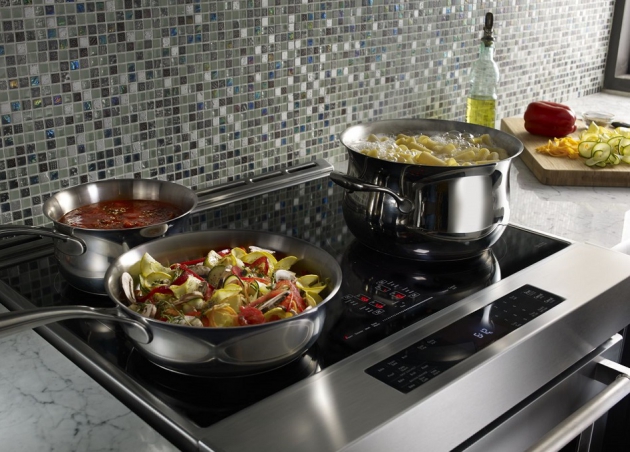A good range is an asset in any kitchen, but one new technology you may not have considered is an induction range. Induction technology is relatively new, but it already has a reputation for excellent energy efficiency and cooking performance. An induction range is easy to use and considerably more energy efficient compared to its electric counterpart. If you’re still unsure, here we’ll examine this type of product in more detail, so you can make an informed decision for your next range upgrade.
How Induction Cooking Works
Induction uses electric currents to heat pots and pans directly through magnetic induction. Rather than using the thermal conduction needed for gas or electric elements to transfer heat, induction heats the cooking vessel itself.
In simple terms, an electric current passes through coiled copper wire under the cook surface to create a magnetic current through the cooking pan, which produces heat. Since induction does not require an outside heat source, only the element that is being used will become warm. There is very little energy lost, as all the heat is transferred to the pan.
The Pros and Cons of Induction
There are both advantages and disadvantages of induction compared to gas or electric ranges. It is important to be aware of both the pros and cons, so you can make an informed decision.
The Pros:
- Faster Cooking: Since induction can create instant heat inside your pots and pans, it is highly efficient. In fact, you can boil water up to 50% faster compared to using an electric cooktop.
- Precise Control: Induction also allows you to control the heat more precisely compared to both electric and gas cooktops. With better temperature control and consistent heat, you can reduce the risk of under or overcooking.
- Easy Clean: Induction cooktops have a smooth surface that resembles a modern electric cooktop. The key difference is that almost immediately after use, the cooktop will be cool enough to wipe away any mess. This means that any spills do not have a chance to bake on to the surface or solidify.
- Burners that Auto Size: Since induction heats using electromagnetic currents, many induction models have auto sizing. This is a form of pan detection that ensures that heat is only placed where it is needed. So, you don’t need to worry about wasting energy by having a small pot on a large burner.
The Cons:
- Higher Initial Cost: Induction ranges tend to be more expensive than their gas or electric alternatives. Additionally, there are only certain types of pots and pans that are compatible with this type of cooktop. So, in addition to investing in a new range, you may need to upgrade your cookware.
- Learning Curve: When you start using an induction cooktop, you will need to be prepared for a learning curve. Many of the standard cooking techniques will not work with induction, so you will need to take some time to learn how to use the surface. The heating times are far faster, so you will need to be ready with your ingredients or you’ll risk burned food.
Other Features of Induction Ranges
In addition to an efficient cooktop, induction ranges can offer some other great features. Many induction range models feature highly efficient convection ovens with self cleaning functions. There may also be a quick preheat function, so you can get cooking and baking with no delay.
If you’re considering upgrading your range, induction ranges are a great option. If you would like to explore the options, browse our online induction range collection or speak to one of our home appliance specialists for further help and guidance.

